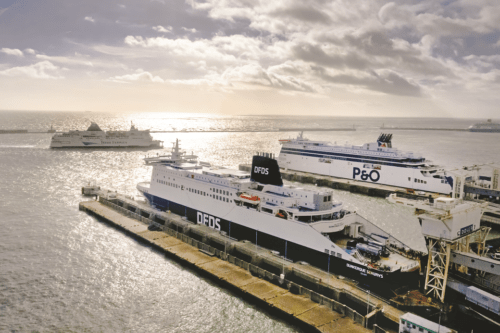
PORT OF DOVER
Jonathan Welch speaks to Port of Dover CEO Doug Bannister and CPT’s Graham Vidler about how the port has addressed the issues which faced coaches earlier this year
There can’t be a single person in the UK who hasn’t heard of Dover, and doesn’t know of the vital role its port plays in moving traffic to and from continental Europe. A huge proportion of the UK population has probably passed through the port at some time or another, its famous white cliffs, topped with Dover Castle, receding into the distance or providing a welcome sight for those returning home.
It will come as no surprise that the Port of Dover is the busiest international ferry port in the UK, with two million cars and 11 million passengers passing through every year. That’s equivalent to a sixth of the UK population, or the entire population of Belgium, Sweden or Cuba. Added to that, of course, are the approximately 2.4 million trucks per year, more than all other UK ports, and £144bn of trade in goods, making up 33% of the UK’s trade with the EU. Not only that, but Dover is also the UK’s second busiest cruise port, welcoming more than 25 cruise ships and 200,000 cruise passengers each year.
What about coaches, you might ask. The demand there is more cyclical, and there’s certainly not 2.4 million of them per year, but they still represent a significant volume of business for the Port and its ferry operators DFDS, Irish Ferries and P&O. For the most part, coaches, like other traffic, passes through relatively easily, but unlike HGVs, the ‘cargo’ on board coaches is much more vocal and demanding when things go wrong, as happened at Easter when a combination of factors led to significant delays for outbound coaches, with some operators reporting 15-plus hour waits.
Thankfully, though maybe of little solace to those who were caught up in it at the time, the Port has worked hard to put new procedures in place to mitigate against any repeat of such scenes, and reports that the start of the peak summer holiday period saw traffic flowing much more smoothly.
Peak period
[…]By subscribing you will benefit from:
- Operator & Supplier Profiles
- Face-to-Face Interviews
- Lastest News
- Test Drives and Reviews
- Legal Updates
- Route Focus
- Industry Insider Opinions
- Passenger Perspective
- Vehicle Launches
- and much more!


